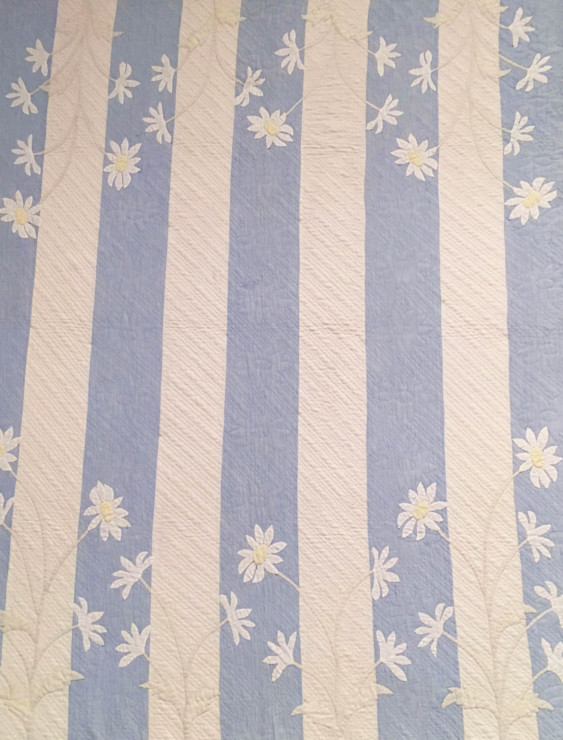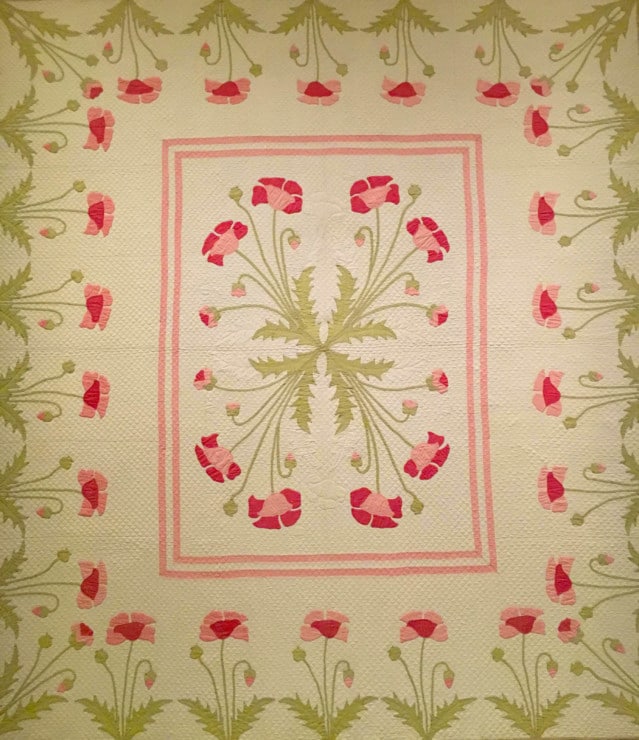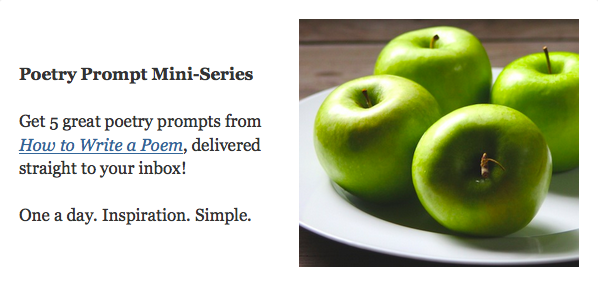Recently, my mom passed along her sewing machine to me. Her aging eyes make even threading a needle hard these days, but my eyes can still see the tiny hole just fine, so I’ve taken up sewing. I started small with pillows. Eventually, I used a pattern to make two reusable shopping bags. Currently, I’m working on a blouse with a collar and buttons, all advanced techniques to this novice.
My newfound sewing interest prompted me to check out a recent exhibit at the Indianapolis Museum of Art called A Joy Forever: Marie Webster Quilts. I was with my husband on an anniversary getaway to the city. Since we had no particular agenda and couldn’t check into the hotel for hours, we decided to spend a couple of hours at the museum, where we are members. We’d already seen the featured exhibit, an homage to our state’s two hundredth birthday, on a previous visit, and we’d swung through “Chemistry of Color, ” an historical representation of how colors were discovered.
We glided up the escalator and wound our way to the opposite corner where subdued gallery lights illuminated dozens of applique quilts. From the museum labels, we learned that Webster was a Hoosier seamstress who, in her early 60s, launched a popular mail-order business in 1921 selling applique quilt patterns and finished quilts. Many of her quilt designs were even featured in popular women’s magazines of the day, including The Ladies Home Journal.

“This one looks like it’s been used a lot, ” Steve said, standing in front of Magpie Rose, a rather faded and yellowed quilt. After reading the description, we realized that it actually had been used quite frequently in Webster’s family home. In fact, a couple of flowers that looked much brighter than the others had subsequently been applied in a rather unpredictable pattern to cover rips and stains that had developed.
We made our way slowly through the 25 quilts, even a few inspired but not made by Webster, and by the end, I think Magpie Rose might have been my favorite. Not because I preferred its design but because I liked its story, the way this very utilitarian object—a quilt to keep warm with—had also been made so beautifully
This makes sense, considering Webster’s influence by the Arts and Crafts movement of the early 20th century. The driving principle behind the movement was “art for life’s sake, ” rather than the “art for art’s sake” of the Victorian era. The movement also emphasized nature and simplicity of form, a trait seen keenly in Webster’s quilts inspired by her own garden.
Interestingly, one of the “fathers” of the Arts and Crafts movement was the poet William Morris, who, according to the Metropolitan Museum of Art, “believed that industrialization alienated labor and created a dehumanizing distance between the designer and manufacturer.” He also believed art should be both beautiful and functional.

that those expressions of happiness are actually art in the hand of a skilled artisan, which means art by its nature is intrinsically connected to our everyday lives and work. He continues:
“A most kind gift is this of nature, since all men, nay, it seems all things too, must labour; so that not only does the dog take pleasure in hunting, and the horse in running, and the bird in flying, but so natural does the idea seem to us, that we imagine to ourselves that the earth and the very elements rejoice in doing their appointed work; and the poets have told us of the spring meadows smiling, of the exultation of the fire, of the countless laughter of the sea.”
Morris speaks knowingly of the poet’s ability to express this happiness of labor, and indeed, it seems that poets, though not usually associated with the Arts and Crafts movement, inherently capture its very spirit in the inseparability of beauty and function. Just as Marie Webster could have sewn plain quilts that kept her family plenty warm, language so permits us to speak plainly and straightforwardly. As Morris described, we could simply say we are happy in our work and be done. Period.
Or, like Webster’s flowers and flourishes that expressed her happiness in her work through simple designs and appliques, we can wrap ourselves and our loved ones up in beautiful words, cozying up with the quilted artistry poetry provides. And along with Morris, we can look beyond a simple seaside picnic in a field, to see “the spring meadows smiling, ” to marvel at “the exultation of the fire, ” and to giggle along with “the countless laughter of the sea.”
Featured image by Brian Lippincott, Creative Commons license via Flickr. Quilt photos and post by by Charity Singleton Craig, co-author of On Being a Writer: 12 Simple Habits for a Writing Life that Lasts.
Browse more Indianapolis Museum of Art
- Grammar for a Full Life Book Club: On Becoming Less Possessive - June 16, 2021
- Grammar for a Full Life Book Club: Chilling Out on the Grammar Rules - June 9, 2021
- Grammar for a Full Life Book Club: A Passive Voice - June 2, 2021


Maureen says
Sounds like a lovely exhibit, Charity. I have a couple of Amish quilts that I love (I bought them directly from their maker) and a baby’s quilt I hope I’ll pass on to my son.
If you come to Washington, D.C., Charity, you’ll want to visit the Textile Museum at GWU.
Charity Singleton Craig says
It was lovely, Maureen, in a dozen surprising ways. Quilts are such works of art. I hope someday to be able to make one. Thanks for your comment.
Lane Arnold says
They are a delight to behold, to create, to gift to others. After decades away from quilting, in the last two years, I’ve made 4 baby quilts and one quilt for newlyweds. This year I am planning to make at least one baby quilt, one wall hanging quilt, and several other ones for various family members. Who knows? Maybe I’ll even get around to making one for us! I’m hoping to leave a legacy in my quilting life.
Charity Craig says
I did think of you as I was writing this, Lane. You are a quilter extraordinaire. I wonder: do you make applique quilts? Or pieced quilts? Or maybe a combination? The long line of quilters I come from mostly made pieced quilts, but they also were a sight to behold.
I’d love to see some pictures of your quilts some time. Maybe you could email me? Thanks!
Sandra Heska King says
Since we’ve moved, I’ve been looking at all my quilting supplies, wondering if I’d ever really make any again. I can’t quite make myself give them up. I think the Poppy is my favorite.
Charity Craig says
I love that you are just holding on to your supplies. I tend to get rid of anything I’m not using, but I do have a small collection of art supplies that I’m also holding onto. Having them remains part of who I am … or at least who I want to be.
I’m hoping to make some time for sewing today. Now I’m thinking my next project should maybe be a quilt!
Prasanta says
My mother has gifted her children and grandchildren with several quilts; I look upon them as cherished heirlooms. Such love and meticulous detail goes into making them. Thank you for sharing this visit, Charity! (And lovely to meet you personally recently!) 🙂
Marcy says
Beautiful Charity! I took myself on an overnight momcation and spent an afternoon st the IMA. Love the exhibit of quilts. So I much love and intention in each stitch. Talking about slowing life down. 💗
Charity Craig says
Yes, quilting … and especially hand stitching … is really a slow process. Glad you got to see the exhibit on your momcation.
Katie says
Such beauty!
Would like to put a plug in for my extremely talented sister-in-law Margaret who has her own quilt design business, Eye of the Beholder (original designs inspired by the world around us); applique patterns for hand and machine. http://www.eobquiltdesign.com
Charity Craig says
Very cool, Katie! I visited Margaret’s site, and it’s awesome! It’s so nice that she also offers some tutorials. I’ve bookmarked it to look at later … maybe I’ll try my hand at an applique quilt some day.
Katie says
Glad you enjoyed Margaret’s site:)